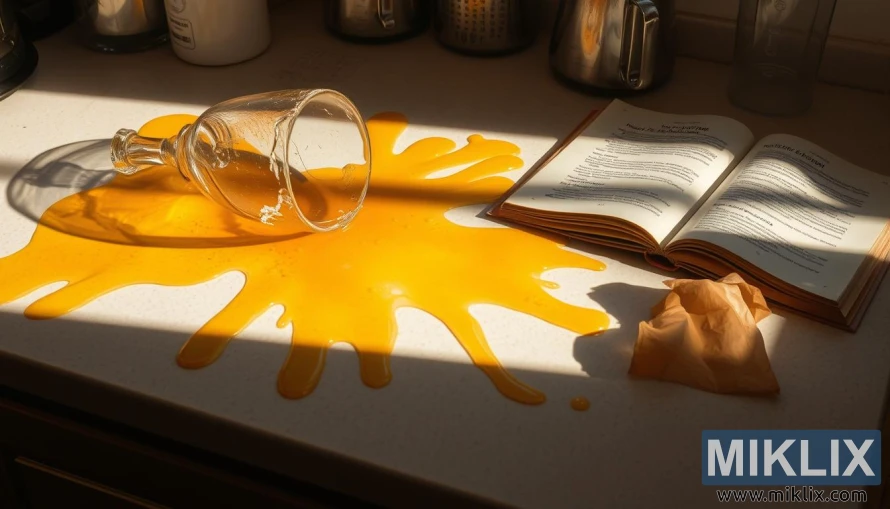Using Candi Sugar as an Adjunct in Beer Brewing
Published: July 20, 2025 at 11:08:49 AM UTC
Beer brewing is an art that requires a precise balance of ingredients and processes. Candi sugar, a common adjunct, is key in crafting complex and flavorful beers. Grasping the role of candi sugar is vital for brewers aiming to enhance their beers. Whether you're an experienced brewer or new to the craft, mastering candi sugar is critical. It's essential for achieving the desired flavors and textures in your brews.

Key Takeaways
- Candi sugar is a versatile adjunct in beer brewing.
- It adds complexity and flavor to beers.
- Understanding its function is critical for brewers.
- Candi sugar can be used to achieve specific flavor profiles.
- Mastering its use is essential for both novice and experienced brewers.
Understanding Candi Sugar in Beer Making
Candi sugar is a key ingredient in beer making, most notable in traditional Belgian brewing. It's created by slowly cooling a supersaturated sucrose solution, resulting in large crystals. This method gives candi sugar its unique qualities, highly prized in brewing.
In beer making, candi sugar is vital for crafting unique and complex flavors. It comes in various forms, including sucrose, dextrose, and maltodextrin. Each type is used differently to achieve distinct flavor profiles and beer styles. The choice of candi sugar depends on the brewer's objectives, such as boosting flavor, improving fermentability, or adjusting the beer's body.
Using candi sugar in brewing is more than just adding sweetness. It's about achieving a balanced flavor. Brewers meticulously choose the type and amount of candi sugar for their recipes. This choice greatly influences the final product's character. Whether in traditional Belgian styles or modern craft beers, candi sugar remains a versatile and valuable ingredient.
- Candi sugar enhances the flavor and complexity of beer.
- Different types of candi sugar are used for specific brewing effects.
- The careful selection of candi sugar is critical for achieving the desired beer characteristics.
The Science Behind Candi Sugar's Impact on Beer
The use of candi sugar in brewing is deeply rooted in its effect on yeast activity during fermentation. Candi sugar, a crystallized inverted sugar syrup, is a blend of glucose and fructose. This mix makes it easily digestible by yeast, encouraging fermentation without stressing the yeast.
During fermentation, yeast breaks down candi sugar, producing alcohol and carbon dioxide. This process not only boosts the beer's alcohol content but also enriches its flavor and aroma. The ease with which yeast ferments candi sugar allows brewers to achieve higher alcohol levels without over-stressing the yeast.
- Candi sugar promotes healthy fermentation.
- It contributes to increased alcohol content.
- Enhances the beer's flavor profile.
The science behind candi sugar's impact on beer is closely tied to its chemical composition and how it interacts with yeast during fermentation. By understanding these interactions, brewers can better control the brewing process. This results in beers with complex and desirable characteristics.
Key factors influenced by candi sugar include:
- Fermentation rate and efficiency.
- Yeast health and viability.
- Final alcohol content and flavor profile.
Different Types of Candi Sugar for Brewing
The world of candi sugar is vast, providing brewers with various options for their recipes. Candi sugar, a key ingredient in many Belgian beers, comes in different forms. Each type has its own unique qualities and uses in brewing.
- Rock candi sugar: Known for its crystalline structure, it adds depth and complexity to beers.
- Liquid candi sugar: Offers a convenient alternative to rock candi sugar, with a similar flavor profile.
- Dark candi sugar: Imparts a rich, caramel-like flavor and color to beers.
Choosing the right type of candi sugar is critical. Brewers must consider their beer's flavor profile and color. The type of candi sugar used can greatly affect the beer's character. It's essential to pick the right one for the brew.
The amount of candi sugar added is also key. Brewers need to balance candi sugar with other ingredients. This balance is vital to achieve the desired beer characteristics. Understanding the different types of candi sugar and their uses can elevate a beer's quality and authenticity.
Benefits of Using Candi Sugar in Your Brew
Using candi sugar in brewing is a time-honored tradition. It boosts alcohol content and enriches flavor profiles. A key advantage is its ability to increase alcohol without overworking the yeast or altering the beer's body.
Candi sugar significantly influences your beer's taste. It leads to cleaner fermentation, making the beer crisp and balanced. It also adds complexity and depth to the brew's character.
- Increased alcohol content without added body
- Improved flavor profiles through cleaner fermentation
- Enhanced overall character and complexity of the beer
Adding candi sugar to your brew can result in a more refined and complex beer. It's perfect for traditional Belgian ales or new recipes. Candi sugar is a valuable tool for achieving your brewing aspirations.

How Candi Sugar Affects Beer Character
Candi sugar is a key player in shaping beer's flavor, color, and body. It significantly influences the final product, adding complexity and depth. This ingredient is essential in brewing, making a big difference in the beer's character.
Adding candi sugar can enhance a beer's flavor profile, introducing unique characteristics. These are highly valued in certain styles, like Belgian ales. Different colors and types of candi sugar offer distinct flavors and colors, enriching the beer.
Candi sugar also affects the beer's body by increasing wort viscosity. This results in a smoother, more rounded palate. It's very beneficial in low-malt beers, adding body without overpowering other flavors.
The impact of candi sugar on beer character can be broken down into several key areas:
- Flavor: Adds complexity and unique flavor notes.
- Color: Contributes to the beer's color, depending on the type of candi sugar used.
- Body: Increases viscosity, resulting in a smoother palate.
By carefully selecting the type and amount of candi sugar, brewers can achieve the desired characteristics in their beer. This makes candi sugar a versatile ingredient in the brewing process.
Selecting the Right Candi Sugar for Your Beer Style
The choice of candi sugar significantly impacts the final beer. With various options, brewers must weigh several factors to pick the right one for their beer style.
When selecting candi sugar, brewers should think about the flavor they want to achieve. Different sugars add unique tastes, from subtle sweetness to deep caramel notes. For example, amber candi sugar is commonly used in Belgian ales to enhance depth and complexity.
The brewing process also plays a role in choosing candi sugar. The timing of addition, whether during the boil or as a priming sugar, shapes the beer's final taste. The type of sugar can also influence fermentation, as yeast reacts differently to various sugars.
To effectively pair candi sugar with your brew, consider these key factors:
- Desired flavor profile: Different candi sugars offer unique flavor characteristics.
- Alcohol content: Candi sugar affects the beer's gravity and alcohol level.
- Brewing tradition: Certain beer styles, like Belgian Tripels, traditionally use specific types of candi sugar.
Understanding these factors and choosing the right candi sugar can elevate your beer's quality and character. This ensures it meets the expectations of the target beer style.
Proper Timing: When to Add Candi Sugar During Brewing
Brewing with candi sugar demands precision, most importantly in timing its addition. The brewing process has various stages, and knowing when to add candi sugar is vital. This ensures the desired flavor in your beer.
Candi sugar can be added at different times, usually during boiling or as primings before bottling. Adding it during boiling lets the sugar dissolve fully into the beer. This enhances the beer's character and alcohol content.
The timing of candi sugar addition impacts fermentation. Adding it too late may not allow full fermentation. This could leave residual sweetness in the beer.
To ensure candi sugar is fully incorporated, brewers must consider several factors. These include the type of sugar, brewing method, and the beer style. Proper timing and technique are essential to fully benefit from candi sugar in beer brewing.
Calculating Candi Sugar Amounts for Your Recipe
To brew beer with the perfect balance of flavors, understanding how to calculate candi sugar amounts is essential. Calculating the right amount of candi sugar is critical for achieving the desired flavor and character in your beer.
The amount of candi sugar used can significantly impact the final product. It contributes to the beer's gravity, flavor, and overall character. Brewers must carefully calculate the amount needed for their recipe.
Several factors need to be considered when calculating candi sugar amounts. These include recipe size, brewing process, and desired flavor profile. The size of the recipe will directly influence the total amount of candi sugar required.
To calculate candi sugar, brewers can follow a simple process:
- Determine the recipe size and type of beer being brewed.
- Decide on the percentage of candi sugar to be used based on the recipe's requirements.
- Calculate the total amount of candi sugar needed using the recipe size and percentage decided upon.
For example, if you're brewing a 5-gallon batch of Belgian ale and want to use 10% candi sugar, you'll need to calculate 10% of the total fermentables.
Here's an example calculation: For a 5-gallon batch with 10 lbs of total fermentables, 10% candi sugar would be 1 lb of candi sugar.
By following these steps and considering the factors mentioned, brewers can accurately calculate the candi sugar amounts needed for their recipes. This leads to a more balanced and flavorful final product.

Traditional Belgian Styles Using Candi Sugar
The use of candi sugar in brewing is a hallmark of traditional Belgian beer styles. It contributes to their distinctive flavor profiles. Belgian brewers have mastered the art of incorporating candi sugar into their recipes. This results in beers that are both complex and refined.
Belgian strong ales, tripels, and quadruples are among the most renowned styles that utilize candi sugar. These beers are characterized by their high alcohol content, rich flavors, and an intriguing balance of sweetness and bitterness. Candi sugar plays a key role in achieving these characteristics. It contributes fermentable sugars that enhance the beer's alcohol content and flavor.
The history of using candi sugar in Belgian brewing dates back centuries. It is believed that the practice originated as a means to create stronger, more robust beers that could be stored for longer periods. Over time, brewers refined their techniques. They developed unique methods for producing and incorporating candi sugar into their brews.
Some of the key characteristics that candi sugar imparts to Belgian beers include:
- Enhanced complexity and depth of flavor
- Increased alcohol content without adding body
- A balanced sweetness that complements the beer's other flavor components
- A distinctive character that is both rich and refined
Brewing traditional Belgian styles with candi sugar requires a deep understanding of how this ingredient interacts with other components of the beer. By carefully balancing the amount and type of candi sugar used, brewers can create beers that are true to their heritage. They also showcase their own unique brewing style.
Common Mistakes When Using Candi Sugar
Using candi sugar in beer recipes can be challenging, with several common errors to watch out for. Brewers, new to candi sugar, should be aware of these pitfalls. This ensures their beer meets their expectations.
One major mistake is miscalculating the candi sugar amount. Too little might not achieve the desired flavor or color. On the other hand, too much can make the beer overly sweet or disrupt its balance.
To sidestep these problems, brewers should follow a recipe or guide that includes candi sugar. It's also vital to grasp how candi sugar influences the beer's gravity and flavor.
- Ensure accurate measurement of candi sugar.
- Understand the impact of candi sugar on the beer's gravity.
- Fully dissolve candi sugar during the brewing process.
Another frequent error is not fully incorporating candi sugar into the brew. This can cause uneven flavor and impact the beer's character. Brewers must ensure candi sugar is fully dissolved, usually by adding it during the boil.
Some brewers also overlook the type of candi sugar they use. Different types offer distinct flavors and colors. Choosing the right type for the beer style is essential.
- Choose the right type of candi sugar for your beer style.
- Add candi sugar at the appropriate time during brewing.
- Monitor the beer's progress to adjust candi sugar amounts as needed.
By recognizing these common mistakes and taking steps to avoid them, brewers can successfully use candi sugar. This enhances their beer's flavor and character.

Making Your Own Candi Sugar at Home
Candi sugar, a key ingredient in Belgian brewing, can be crafted at home with basic ingredients. This DIY approach gives brewers full control over the candi sugar's type and quality. It's a way to enhance their beers.
To begin, you'll need granulated sugar, water, and optionally, cream of tartar. You'll also require a saucepan, a candy thermometer, and a heat-resistant container for cooling.
The process begins with dissolving sugar in water to form a syrup. Then, heat it to a precise temperature to achieve the right consistency and flavor. Here's how to do it:
- Combine granulated sugar and water in a saucepan. Use a 2:1 ratio of sugar to water.
- Add a pinch of cream of tartar to prevent sugar crystallization.
- Heat the mixture over medium heat, stirring until the sugar is fully dissolved.
- Bring the syrup to a boil, then lower the heat to a simmer.
- Monitor the temperature with a candy thermometer. Aim for around 350°F (175°C) for dark candi sugar.
- Remove from heat once the desired temperature is reached. Let it cool slightly.
- Pour the candi sugar into a heat-resistant container to cool and set.
For the best results, use high-quality granulated sugar and be patient during cooling. The candi sugar can be used right away or stored for later.
Making your own candi sugar allows you to experiment with flavors and colors. This adds a unique touch to your homebrewed beers.
Comparing Candi Sugar to Other Brewing Adjuncts
Candi sugar is a favorite among brewers, but how does it stack up against other sugars and adjuncts? The brewing world offers a variety of options for adding adjuncts to beer recipes. Each has its own unique qualities, uses, and benefits.
Brewing adjuncts are ingredients added to the main ingredients (malt, hops, yeast, and water) to improve flavor, texture, and quality. Common adjuncts include sugars, fruits, spices, and grains. Candi sugar is celebrated for its complex flavors and ability to boost alcohol content without affecting body.
When comparing candi sugar to other adjuncts, understanding their roles in brewing is key. For example, maltodextrin adds body and smoothness, while candi sugar focuses on fermentable sugars and flavor. Adjuncts like honey, maple syrup, and brown sugar bring unique flavors and aromas, giving brewers a wide range of options.
The choice between candi sugar and other adjuncts depends on the brewer's goals for flavor, color, and alcohol content. Here are some key differences:
- Candi sugar is highly fermentable, significantly boosting the beer's alcohol content.
- Maltodextrin, not fermentable, enhances body and mouthfeel.
- Fruit adjuncts add complex flavors and aromas, perfect for sour beers and fruit-infused brews.
- Honey and maple syrup impart unique flavors, from floral to rich and earthy.
In conclusion, while candi sugar is valuable, brewers have many other adjuncts to choose from. Understanding the characteristics and uses of different adjuncts helps brewers make informed decisions. This ensures they achieve the desired beer characteristics.
Storing and Handling Candi Sugar
To ensure candi sugar remains valuable in brewing, understanding proper storage and handling is key.
Like any brewing ingredient, candi sugar needs care to keep its quality and effectiveness. Store it in an airtight container to protect it from moisture and light. This is vital because air exposure can make the sugar lumpy or develop off-flavors.
When using candi sugar, minimize air exposure. After opening, use a clean, dry scoop or spoon to measure. Then, reseal the container tightly.
- Store candi sugar in a cool, dry place, away from direct sunlight.
- Use airtight containers to protect the sugar from moisture.
- Minimize exposure to air when measuring or handling candi sugar.
While candi sugar can last indefinitely if stored right, using it within a year is best for flavor and performance. By following these tips, your candi sugar will remain a reliable ingredient in your brewing.
Conclusion
Understanding candi sugar's role in beer brewing can significantly improve your craft. It allows you to create complex, high-quality beers, rivaling those from famous breweries like Westvleteren and Chimay.
Candi sugar is a versatile ingredient that can enhance your beer's flavor, aroma, color, and body. By choosing the right type and amount, brewers can achieve the desired effects in their beers.
As you experiment with candi sugar, remember the best practices discussed in this article. This includes proper timing and handling. With practice and patience, you'll unlock candi sugar's full benefits, creating exceptional beers.
In conclusion, candi sugar is a valuable tool for brewers, opening up creative possibilities and innovation. As you refine your techniques, consider adding candi sugar to your recipes. It will add depth and complexity to your beers, enriching the brewing process.
Further Reading
If you enjoyed this post, you may also like these suggestions:
- Adjuncts in Homebrewed Beer: Introduction for Beginners
- Using Rice as an Adjunct in Beer Brewing
- Using Wheat as an Adjunct in Beer Brewing
